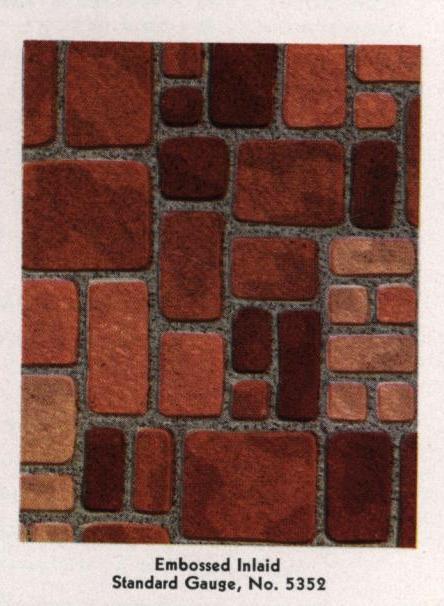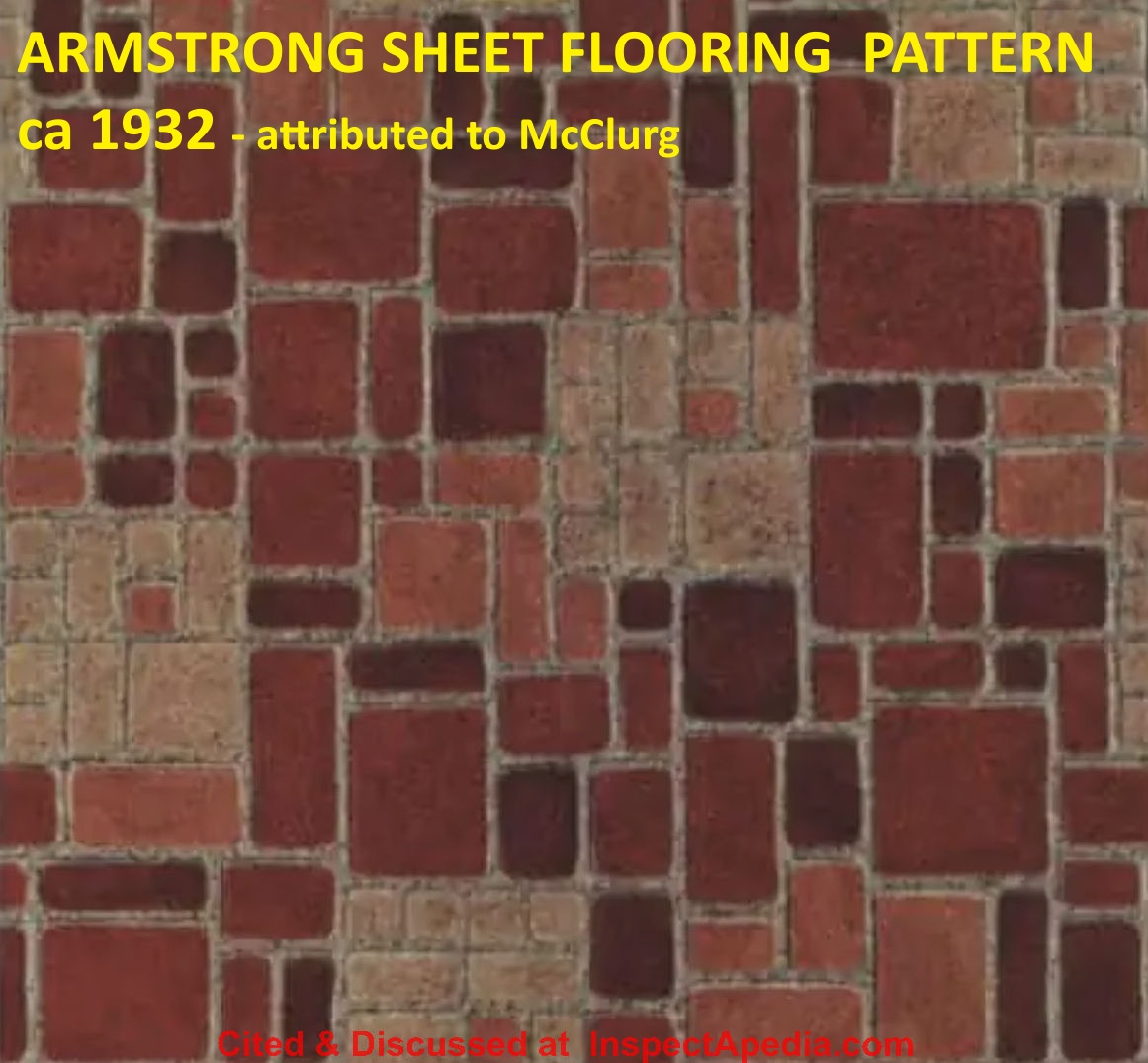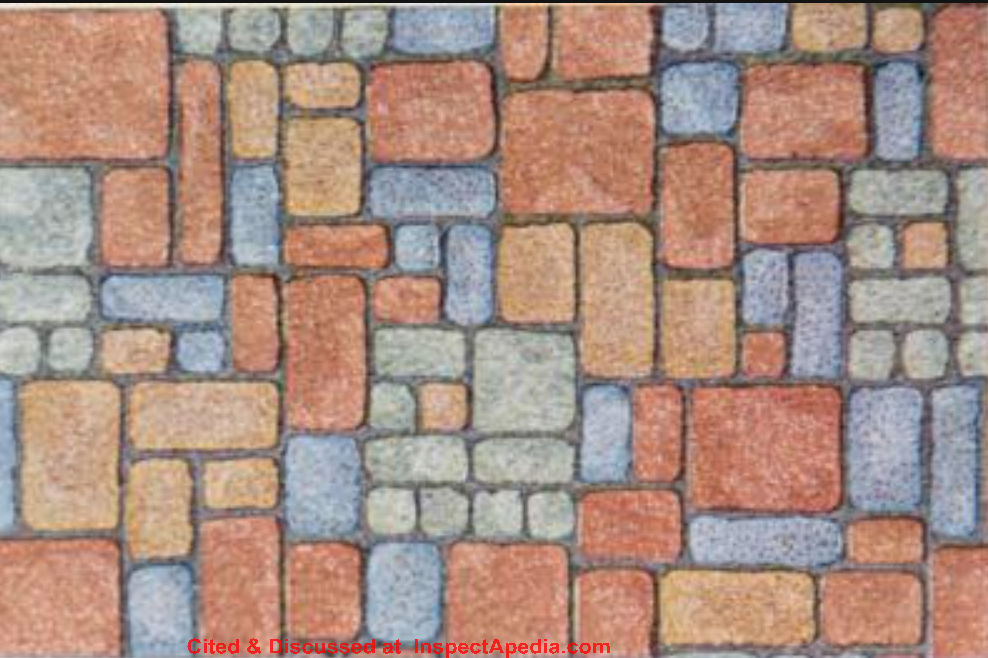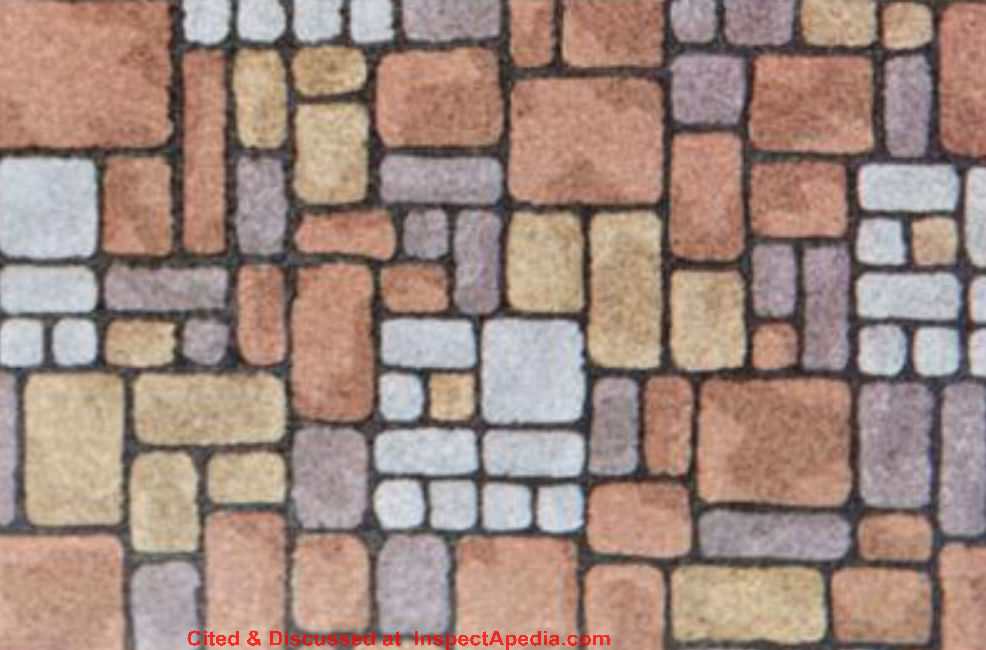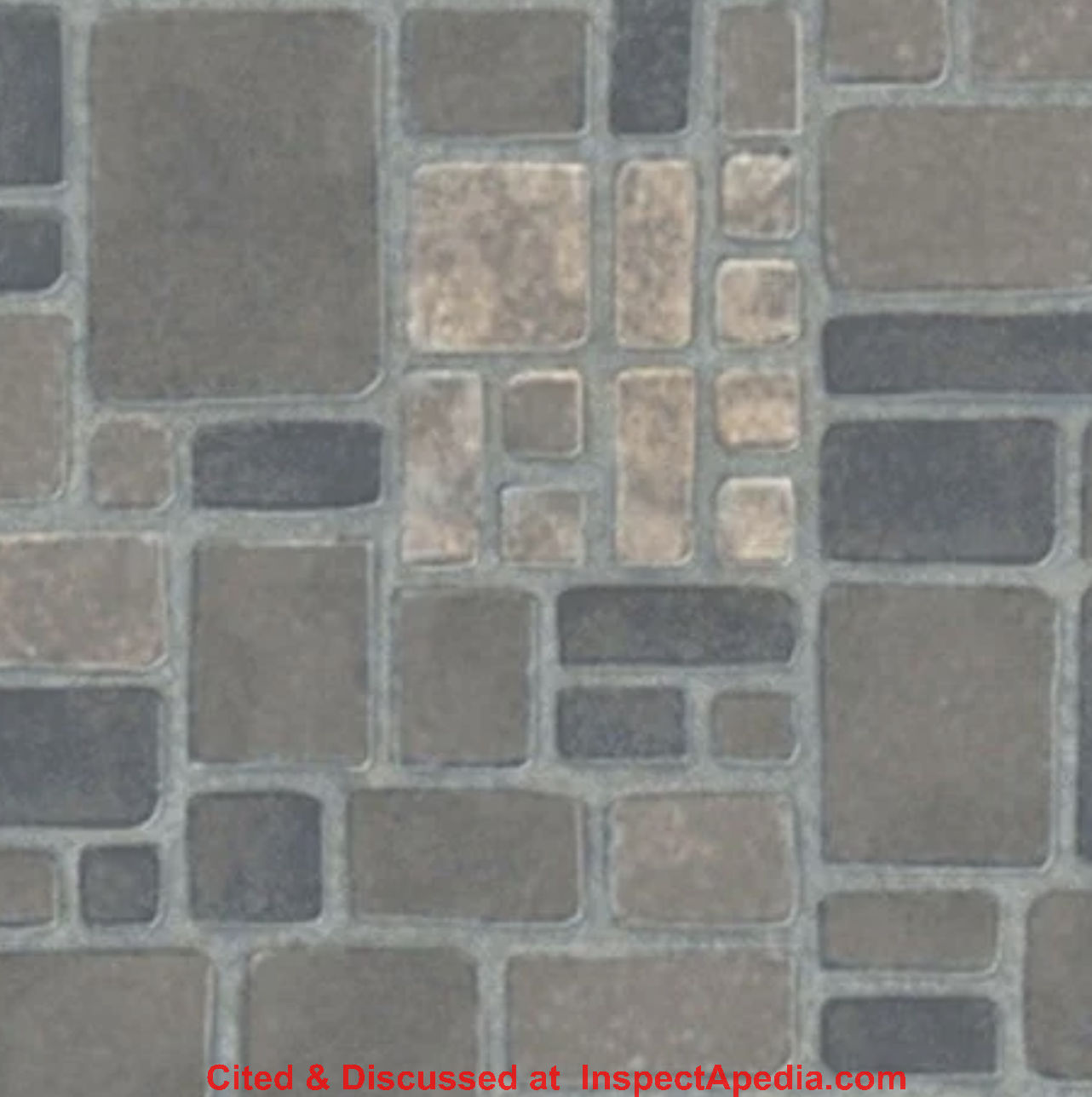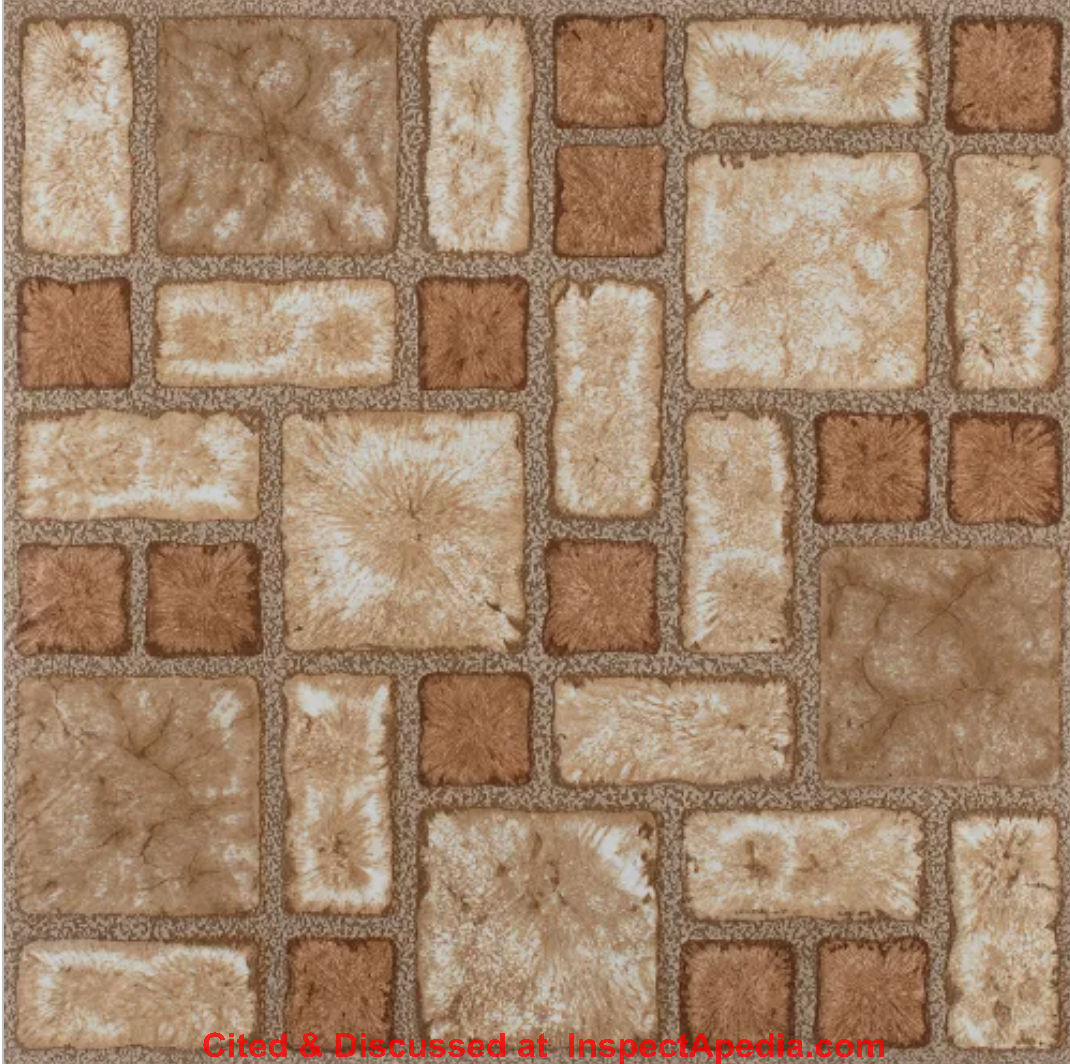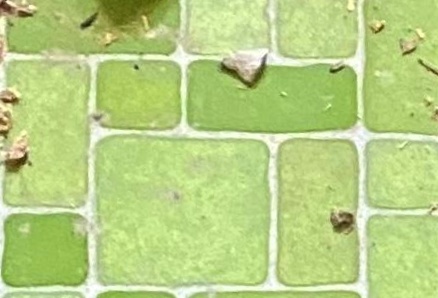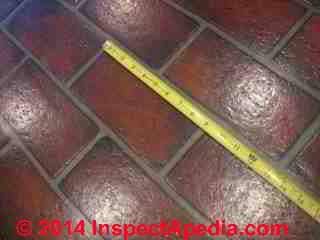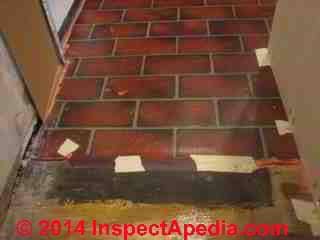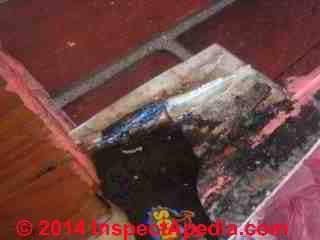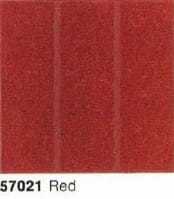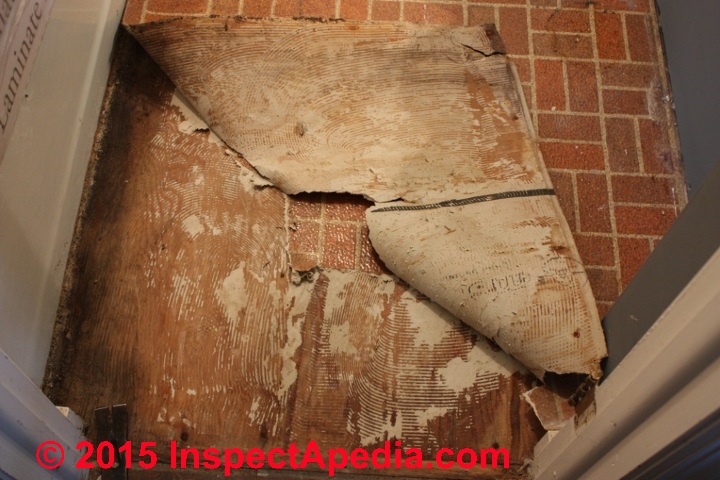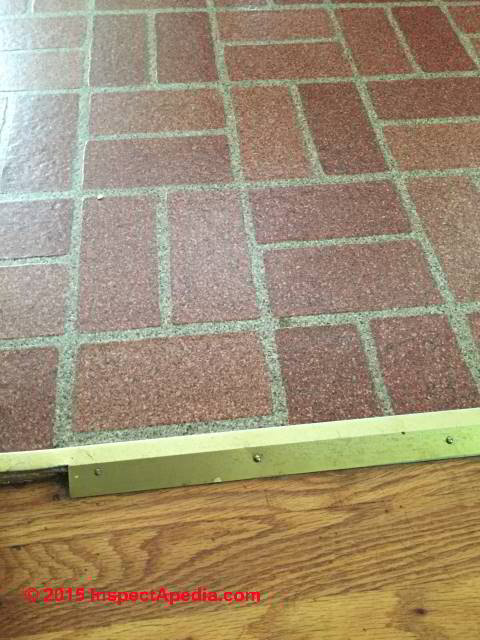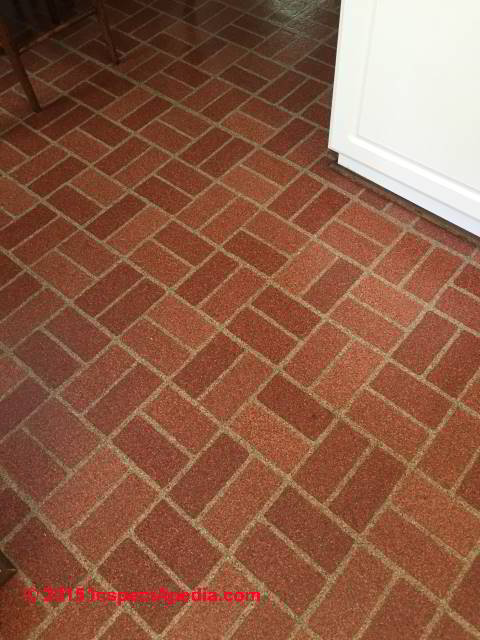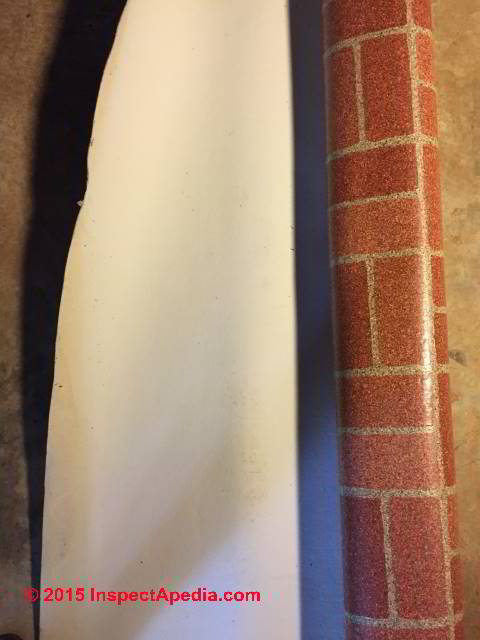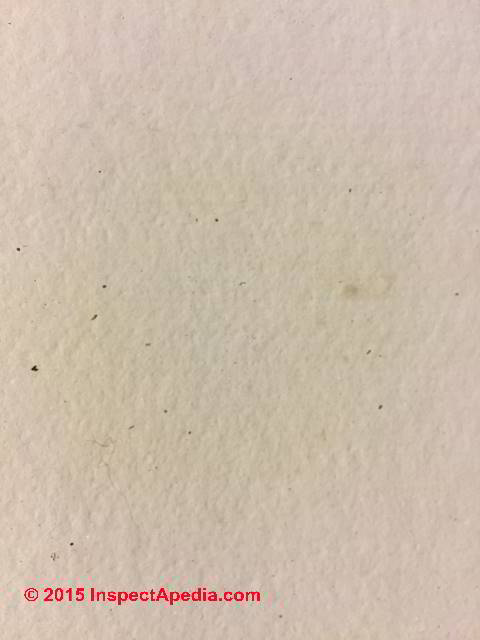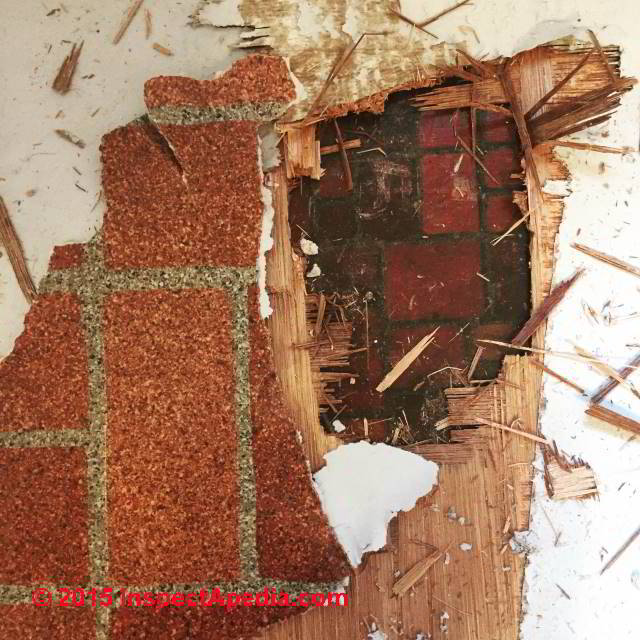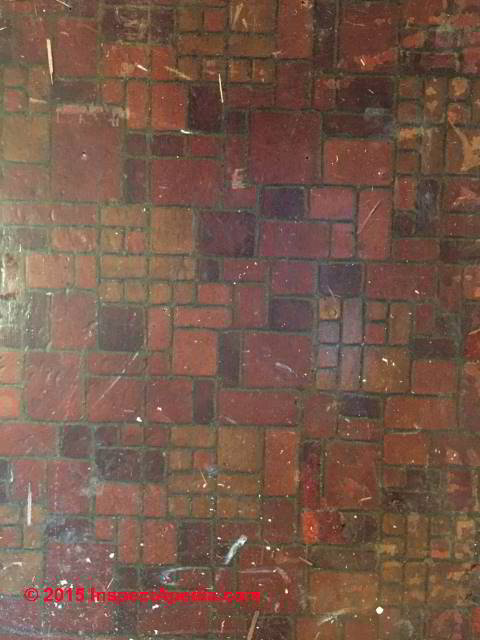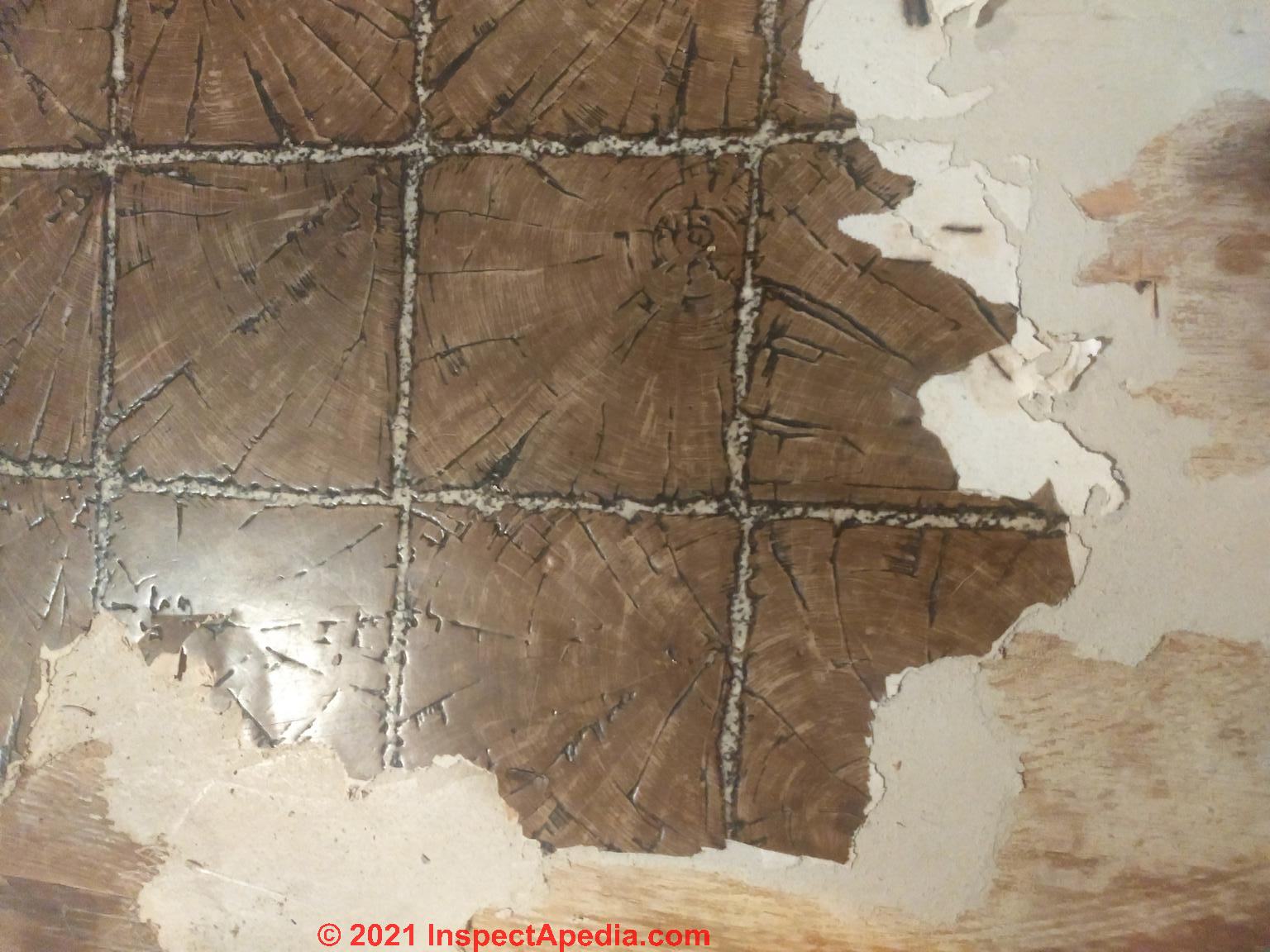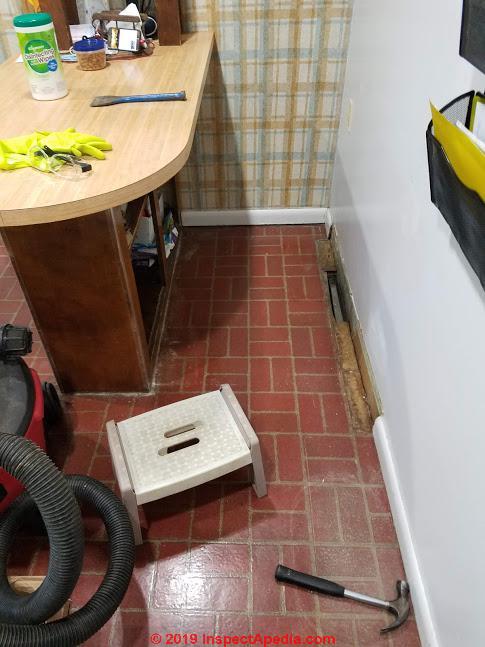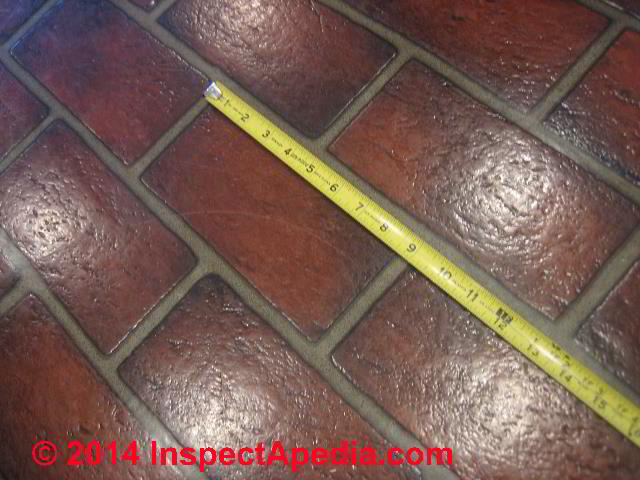 Red Brick Pattern Floor Tiles & Sheet Flooring
Red Brick Pattern Floor Tiles & Sheet Flooring
that May Contain Asbestos
- POST a QUESTION or COMMENT about sheet flooring products that might contain asbestos
Asbestos-containing floor tile and also sheet flooring or resilient flooring product identification for red brick sheet flooring and similar patterns such as Bradford Brick, Romford Brick, Glenmore Brick.
This article describes floor tiles and also sheet flooring, both asbestos-free sheet flooring and sheet flooring products known to contain significant levels of asbestos produced in a red or golden brick pattern between the 1960's to the late 1980's.
Page top photo: Armstrong's Romford red brick pattern sheet flooring.
We also include photographs for identification of known asbestos-containing resilient sheet flooring as well as unknown flooring submitted for identification. The article gives safety and asbestos testing advice for sheet flooring products.
InspectAPedia tolerates no conflicts of interest. We have no relationship with advertisers, products, or services discussed at this website.
- Daniel Friedman, Publisher/Editor/Author - See WHO ARE WE?
Armstrong Bradford Brick / Congoleum Red Brick Pattern Flooring
& Other Brands of brick pattern flooring or floor tiles
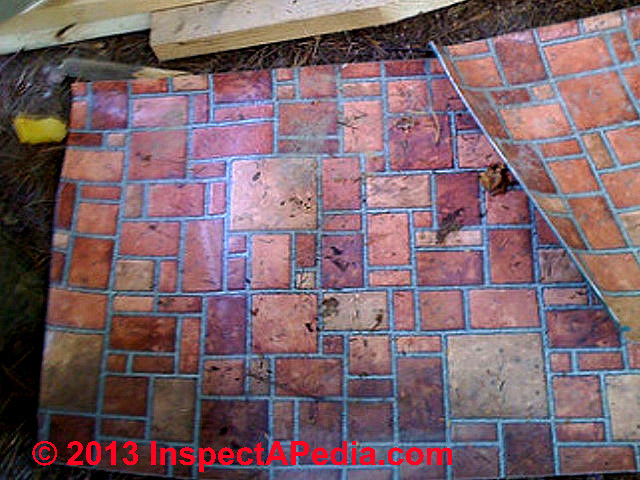 Vinyl Sheet Flooring Asbestos Content Test Results
Vinyl Sheet Flooring Asbestos Content Test Results
Bottom line: asbestos has been confirmed in the backing of some but not all older sheet flooring of various brick-patterns & brick-colored varied-size rectangle patterns of all colors.
This page illlustrates red and other dark brick flooring patterns that contained abestos (often). Separately
at SHEET & TILE FLOORING ASBESTOS ID-WHITE BRICK we illustrate similar brick pattern flooring in tile and sheet form, also confirmed to contain asbestos.
Photo above: an example of Armsrtrong #5352 "Linoleum "red brick" sheet flooring. This pattern, originating in 1932, was sold in other colors including white and green.
Several readers report asbestos test lab results confirmed asbestos in several popular brick-pattern sheet flooring installed in North America as well as some other areas before the mid 1980's.
Watch out: red brick sheet flooring including varied-square-sized flooring like the Armstrong pattern shown here (probably Armsrtrong #5352 "Linoleum") has been found to contain asbestos - 40% chrysotile asbestos.
Adding confusion, some reader's tests of identical-looking flooring (reported later in this article) found no asbestos in their sample.
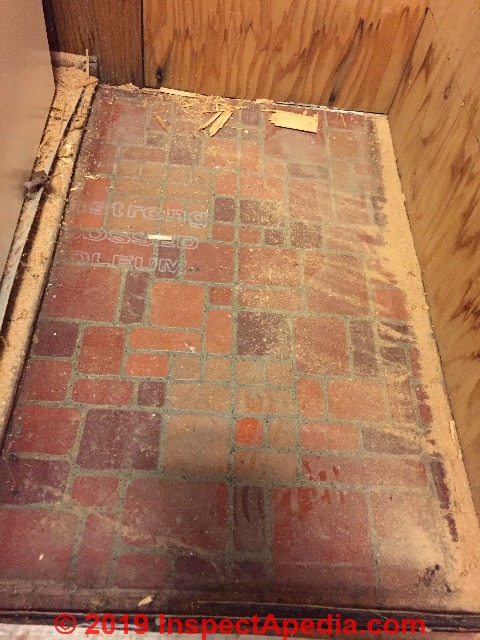 Treat the sheet flooring or vinul tile flooring in brick patterns shown here as PACM - Presumed Asbestos Containing Material - or have a sample of your specific floor tested for asbestos before doing any dust-creating demolition suc as chopping, sanding or sawing the material.
Treat the sheet flooring or vinul tile flooring in brick patterns shown here as PACM - Presumed Asbestos Containing Material - or have a sample of your specific floor tested for asbestos before doing any dust-creating demolition suc as chopping, sanding or sawing the material.
That does not mean that occupants of a building where such flooring was installed is in grave danger from airborne asbestos from the flooring.
Where the floor is not glued down, asbestos or not, it can be removed easily with no significant asbestos hazard.
Where it's glued down, sheet flooring removal needs to consider minimizing dust and cleaning up properly afterwards.
Note too that some floor mastic adhesives also contained asbestos.
When the asbestos-suspect flooring has already been removed but where you are worried about asbestos dust, you can test settled dust or you can simply do more cleaning: damp wiping and HEPA vacuuming.
Red brick vinyl asbestos sheet flooring above and asbestos test results below: here is a reader-supplied Asbestos Test Report for a 1970 home.
Their Armstrong red brick sheet flooring varied-square-sized flooring shown below along with the report was confirmed as containing Chrysotile form asbestos.
If there is a reason concern for high levels of indoor dust that might be significantly contaminated, for example after an interior demolition job that did not control the spread of dust that might be high in asbestos,
provides a general guide to collecting settled dust to send to a qualified laboratory for analysis.
You'll want to know if significant levels of asbestos or other potentially harmful particles are found in the sample.
This approach, while not giving a quantitative "number" in in fact a more-reliable way to assess a remaining asbestos-dust hazard than an "air test" whose variability error can be several orders of magnitude.
Reader Question: does this red brick linoleum sheet flooring contain asbestos?
 We recently purchased a house that was built in 1900 and decided to rip the carpet up because underneath was hardwoods which is what is in the rest of the house.
We recently purchased a house that was built in 1900 and decided to rip the carpet up because underneath was hardwoods which is what is in the rest of the house.
After we ripped it up we noticed what looks like old linoleum backing and glue which we have tried to scrape up and did not think about the risk of asbestos.
Around the very edges of the room there was still 2 inch strips of the old linoleum and I have tried to find the style in the reference pictures you have and I haven't seen any like it so I have attached a picture that is almost identical to what we have to see if you know if contains asbestos or not.
The damage is already done as I have scraped all the glue and old backing up but I am very concerned as it is my daughters bedroom.
I would appreciate any help you could possibly give me as I cannot afford to send off a sample for testing. - J.P. 8/18/2013
Here is a picture of the flooring I have in questions about weather it has asbestos in it or not. I couldn't find a picture of it on your site but I did find a lot of other helpful information.
Our house is from the 40s but i have no idea about the vinyl flooring it has been covered by carpet and other vinyl flooring its becoming the mystery house full of surprise. - J.W. 9/18/2013
Reply: Armstrong #5351, #5352 & #5353 "Linoleum sheet flooring - tiny brick pattern example photos - 1932 to present
J.P.
I think that the sheet flooring in your photos is probably an early version of Arstrong or Congoleum's "Red Brick" vinyl sheet flooring pattern matching y Armsrtrong #5352 "Linoleum" that we show below from a 1961 Armstrong flooring catalog.
Some web articles we reviewed called this material "linoleum" and although I think that word is often used too loosely to simply mean "sheet flooring" the product names are confusing.
For example some Armstrong sheet vinyl floor coverings were labeled as "linoleum".
Below we show an image of this"tiny brick" flooring pattern attributed by Kueber to McClurg and dated as first designed in 1932. This flooring pattern appeared in Armstrong's 1932 sheet flooring (linoleum) catalog in several color choices.
And just below, from Armstrong's 1932 flooring catalog, Armstrong No. 5351 Embossed Inlaid C-Gauge flooring
followed by Armstrong's No. 5353 - the same design a darker shade.
This same flooring pattern wals also sold in Armstrong's 1970's Solarian no-wax flooring line.
Below: modern copies of this same Armstrong 53xx series flooring design
Currently (2024) this flooring pattern is still provided by Armstrong Cushion Step vinyl sheet flooring (shown above) and as Armstrong 12"as well as in self-stick floor tiles; there are also similar designs by Achim (below) also sold by Wayfair and Global Industries.
4 Questions/Answers: Is there Asbestos in this Brick Pattern Sheet Flooring?
Here is how you can be sure to identify a true linoleum floor product (not asbestos-containing) by simple visual inspection - that is, how to tell linoleum from sheet vinyl resilient flooring:
- "Burlap flooring backer"
If the flooring has what looks like burlap or jute backing - on its reverse it's probably very old and not an asbestos-containing product. - Asphalt or felt paper backer
If the sheet flooring has a smooth, non-fabric backing that is black (asphalt-impregnatedfelt), it may contain asbestos and should be treated as PACM - presumed asbestos containing material.
From your photo (above left) this looks like a very-widely used sheet flooring with an impregnated asphalt felt backer - let me know.
Some asphalt-impregnated black felt backers included asbestos. - Asbestos felt backer - white or gray (asbestos felt),
Later white or gray-white "asbestos felt" flooring backing material used on both floor tiles and sheet flooring often contained asbestos up to about 1986 in the U.S. and other years in other countries.
As we report below, a reader obtained an asbestos test lab report on a sample of flooring that looks like that above: the lab did not report finding asbestos in that sample. - If the sheet (or tile) flooring was made in the U.S. after 1986 it's not likely to contain asbestos.
Don't panic, just don't create a dusty mess by using power tools, saws, grinders;
Watch out: that the mastic used to adhere old sheet flooring may also contain asbestos. After trying various solvents on a black mastic years ago I discovered that it was water soluble and came up easily once I let it sit wet for a few hours. Try that.
J.W. Indeed I've found other similar flooring patterns and colors to those in your photo that by date, records, tests, were confirmed as having asbestos in the vinyl backing; it would be prudent to treat the material as presumed-asbestos-containing material.
Below is an xample of Armstrong's #5352 "Linoleum "green brick" sheet flooring, courtesy of an anonymous InspectApedia reader.
Really? Don't panic; non-friable materials like this can usually be handled with a minimum of dust and debris - provided the floor was not glued down;
If you are facing a large cost or have other reasons to be concerned about asbestos contamination in the building it would not be costly to have a small sample of the floor tested.
At the end of this article we include links to information on how to minimize the asbestos hazard from asbestos-suspect sheet flooring or tile flooring.
Reader follow-up from J.P.
It had almost a felt type black backing that is what was still stuck to the floor that I had to scrape and it did get soggy mushy in warm water.
Scraped up fairly easy and the glue I was able to mop up with several times of mopping over the entire floor. Just wanted to see if that is the burlap type backing you were possibly talking about.
Reply:
Watch out: No the backing you describe is not a jute backer; rather it sounds like an asphalt impregnated felt type backer - some of which contained asbestos; wetting and mopping make some sense in that case.
Reader Question & Test Results: 1973 Brick Pattern Vinyl Sheet Flooring & Mastic Adhesive Asbestos Test Results
We are concerned about asbestos in our kitchen sheet flooring. We are 99% sure it is the original floor--as there is nothing underneath it. The Home was built 1973, and we are pretty sure it was Forest City Enterprises who built it (if that helps?).
I attached some pictures.
I carefully wet-scraped up a small piece. It was fairly stubborn if you scraped the bottom part or did not go 'under' the tile fully --almost like sand, but if you scraped below the sheet, it came up easier.
I believe it is an embossed sheet vinyl (has recessed grout lines) the bright orange paint on the edges is what I used to seal any potential dust.
Any thoughts? If there's question and it's possible asbestos, can you suggest a good lab (that reasonable cost) to send a sample to? Thank you for all you guys have done! - R.D. 2/9/2014
Reply:
Given the date of the floor installation (1973) and pattern you should have treated the flooring as presumed to contain asbestos.
It would not perhaps be necessary nor appropriate to test something that is easily rolled up and disposed-of, but you'd have wanted to avoid creating a dusty mess.
Sheet flooring in the brick pattern was popular in both red (yours) and white, and may have had its original pattern design in 12" tile format in the Romford Red pattern (little image at left) as we document
at 1973 - ARMSTRONG EXCELON VINYL ASBESTOS FLOOR TILES where we include additional flooring image links:
Craftlon Romford Brick 9" x 9" x 3/32" vinyl asbestos floor tiles were available in White 57020 and in Red 57021 - shown at above left. Gold patterns appeared later.
If you want to test a sample
see ASBESTOS TESTING LAB LIST for help in finding a certified asbestos test lab.
Typically the asbestos test lab fee is around $50. U.S.
Asbestos is found in older floor tile mastic adhesives, particularly the older black asphalt mastics often contained asbestos, as did other similar mastics used in roofing and flashing cements.
See MASTIC, CUTBACK ADHESIVE, FLASHING CEMENT ASBESTOS
Asbestos is found in some (not all) sheet flooring backing materials as well.
It is possible that this popular vinyl asbestos pattern originated in the early 70's as Armstrong's "Romford Red" which is itself an interesting name as I suspect the name leaked over from Rumford - the colonial Tory who fled the colonies back to Britain during the American Revolution.
Rumford was sent to Bavaria where he developed the measurements on the perfect fireplace design - a specification that many red brick fireplaces as of course other fireplaces later followed. A less likely origin of the name is from Romford in Northeast London.
Here are more examples of widely-sold Armstrong vinyl-asbestos floor tiles in brick patterns. Brick pattern tile flooring was sold in both 9x9" and 12x12" versions.
Armstrong CRAFTLON ROMFORD BRICK (9" x 9" 0.80" gauge) pattern vinyl asbestos floor tiles shown above were sold in WHITE 57020, and RED 57021 (shown below)
Don't confuse this with Armstrong CUSTOM GLENMORE BRICK 12" x 12" x 1/16"
or Armstrong ROMFORD BRICK floor tiles like this example from 1973 shown above
COUNTRY BRICK 12" x 12" regular brick pattern Armstrong vinyl asbestos floor tiles sold in these colors:
TERRA COTTA 57400,
WHITE 57401,
BURNT TOAST, 57402, above and especially recommended for kitchens, ALMOND 57403)
More asbestos flooring brick pattern identification photographs
This brick-like floor pattern was sold in both tile and sheet flooring forms in several colors including red, white, gray, green.
More brick pattern flooring ID photos from this era are at
- ARMSTRONG FLOOR TILE IDENTIFICATION 1974-1979 for more images of brick pattern asbestos containing flooring like the brick Armstrong flooring shown above.
- BRICK FLOOR PATTERN PHOTOS from 1978 - where we show both tile and a continuous sheet resilient flooring product that also used the Romford Brick floor pattern.
- CUSTOM OLD FORGE 12" x 12" x 1/16" (White, 57081) Excelon floor tiles in pattern
- CUSTOM GLENMORE BRICK 12" x 12" x 1/16"
- ROMFORD BRICK floor tiles from (example year) 1973.
- KENTILE RED BRICK FLOOR TILES
- SHEET & TILE FLOORING ASBESTOS ID-WHITE BRICK
Reader Question: no asbestos content in later 1980's era Armstrong Red Brick Pattern Sheet Flooring
We did not find our particular style of Armstrong vinyl sheet flooring on your website and therefore are submitting our photos and information in hopes that you are familiar with the style and know whether or not it contains asbestos.
From our research, we determined that the Armstrong vinyl flooring brick pattern first appeared in the 1970s but continues through today.
The style appears to be most closely related to the Bradford Brick vinyl tile pattern, but the coloring is more varied and it comes in sheet flooring with white paper backing.
The first few pictures are our own (installed kitchen flooring, view of hardwoods and kitchen threshold to flooring, and backing on extra sheeting roll in basement - with no labels or information unfortunately) and the last photo we found online - it confirms that Armstrong was the manufacturer (logo on demo photo).
Our home was built in the 1950s, but the floor was clearly installed at a later date as it is not continuous under the original cabinets and the original hardwood floors can be seen continuing from our living room under the vinyl sheet which is glued to plywood on the hardwood floor (note the height difference and threshold in the kitchen flooring photo).
Any help would be greatly appreciated! We would really love to pull this floor up ourselves and refinish the hardwood underneath!
Thanks so much for your time and consideration! - P.C., Decatur, GA, 2 Aug 2015 [private email]
Reply:
Indeed because this has been such a very long and popular floor pattern in both tile and sheet flooring forms it's difficult to guess reliably about its asbestos content unless we have reason to think that the floor was installed before the mid 1980's.
Some readers have had later flooring tested for asbestos and have confirmed that later, that is newer flooring did not contain asbestos.
If you think the floor is that old or older it's reasonable to treat it as presumed to contain asbestos.
ADVICE: For buildings with floor tiles or sheet flooring that can be assumed to have been installed in North America before 1986 it would be prudent to treat the flooring as "PACM" or "Presumed Asbestos Containing Material".
That does not mean we should panic nor undertake an expensive and dangerous asbestos removal project.
Asbestos is safe and legal to remain in homes or public buildings as long as the asbestos materials are in good condition and the asbestos can not be released into the air.
Generally the safest approach is to leave such flooring alone and to cover it over with a coating or with another layer of flooring.
IF you are faced with a requirement for demolition and if you are uncertain about the flooring's asbestos content and cannot identify it through our guides, then you have a sample tested. At the end of this article we give a link to help with finding an asbestos test lab.
Reader follow-up: the Armstrong brick pattern sheet flooring above did not contain asbestos
I previously spoke with the woman who owned our home from 1987 - 2001 and she claims to have installed the vinyl sheet flooring (along with our green formica countertops - the good 'ol days :), however, I do not know when the product was manufactured.
Are there Armstrong flooring product catalogs available for the 1980s and 1990s? I'm wondering if it would be possible to find out when this color option and style was first introduced - if it was post-1986, we should be in the clear?
I have contacted Armstrong but have not heard back. Thanks again for your help - we'll let you know the results of the test! - P.C. 2 Aug 2015
... we had our floor tested by an accredited lab and confirmed that it did NOT contain asbestos and the glue was modern and safe. However!
1960's-1970's (estimated) Red Brick Pattern Sheet Flooring: test shows no asbestos content
When we removed the layer of vinyl over plywood, and pulled back a section of the plywood, we discovered yet another layer of hidden vinyl sheet flooring glued to our original hardwoods (pictures attached) this appears to be an older model and the company is currently unknown to us.
We will have it tested this week and I'll let you know the results. Your website has been helpful to us and we're happy to contribute our various (!!) test results and photos anonymously, as you see fit. ... - P.C. 15 Aug 2015
Reply:
This flooring pattern is discussed in the article above beginning
at RESILIENT SHEET FLOORING ID GUIDE and described and illustrated as well on this very page.
The owner of that floor did not have a sample tested so your test results will be important.
More examples are
at at ARMSTRONG BRADFORD BRICK SHEET
Other readers' tests of your second flooring example (below) are given higher on this same web page and have confirmed the presence of chrysotile asbestos.
Reader follow-up - no asbestos in the vinyl sheet flooring, black felt backing, or mastic.
Good news! There was not any asbestos in the vinyl sheet flooring, black felt backing, or mastic.
[Click to enlarge any image]
...
Reader Comments, Questions & Answers About The Article Above
Below you will find questions and answers previously posted on this page at its page bottom reader comment box.
Reader Q&A - also see RECOMMENDED ARTICLES & FAQs
Is this vinyl sheet asbestos-containing flooring?
From a log house's kitchen. Vinyl sheet? House built. mid/late 70's-1980. On 2021-01-01 by Jc
Reply by (mod) - aYes; advice for asbestos in flooring in bad shape
For flooring that is in poor condition, either test that flooring or treat it as presumed to contain asbestos
Is this white stuff left after I pulled up linoleum asbestos?
 I tore out carpet to refinish the hardwood and there is a patch of linoleum or vinyl in front of the door.
I tore out carpet to refinish the hardwood and there is a patch of linoleum or vinyl in front of the door.
I pulled up the first layer to find the red brick pattern underneath as pictured.
After hours of scraping with little progress I started looking for how to remove it and found out it could contain asbestos.
The white/gray strip on the right is the back. This house was built in 1925 no idea about when the floor was installed.
Do you think this has asbestos and how worried should I be about exposure?
I am scared to get it tested for the most part I was praying it with an adhesive remover so it was wet. I am not sure if I should continue, call experts or just cover it and seal it back up.
I don’t have money to have an asbestos removal company to come in. I feel stupid I didn’t even think about it have asbestos.
Now in scared I’ve damaged my health and that my dogs could have been exposed as well.
I woods appreciate any advice. On 2020-06-26 by Amanda
Reply by (mod) -
Amanda:
You can damp wipe the area; don't use a conventional household vacuum cleaner as that can increase airborne dust levels. Or if you have access to a HEPA-rated vacuum cleaner you can do additional cleaning with that.
Then cover over the flooring with sheet flooring or another new flooring material.
Details of things you can do to reduce the hazard are at ASBESTOS FLOORING HAZARD REDUCTION
Linoleum & Red brick floor tiles in 1925 home - jute backed linoleum asbestos?
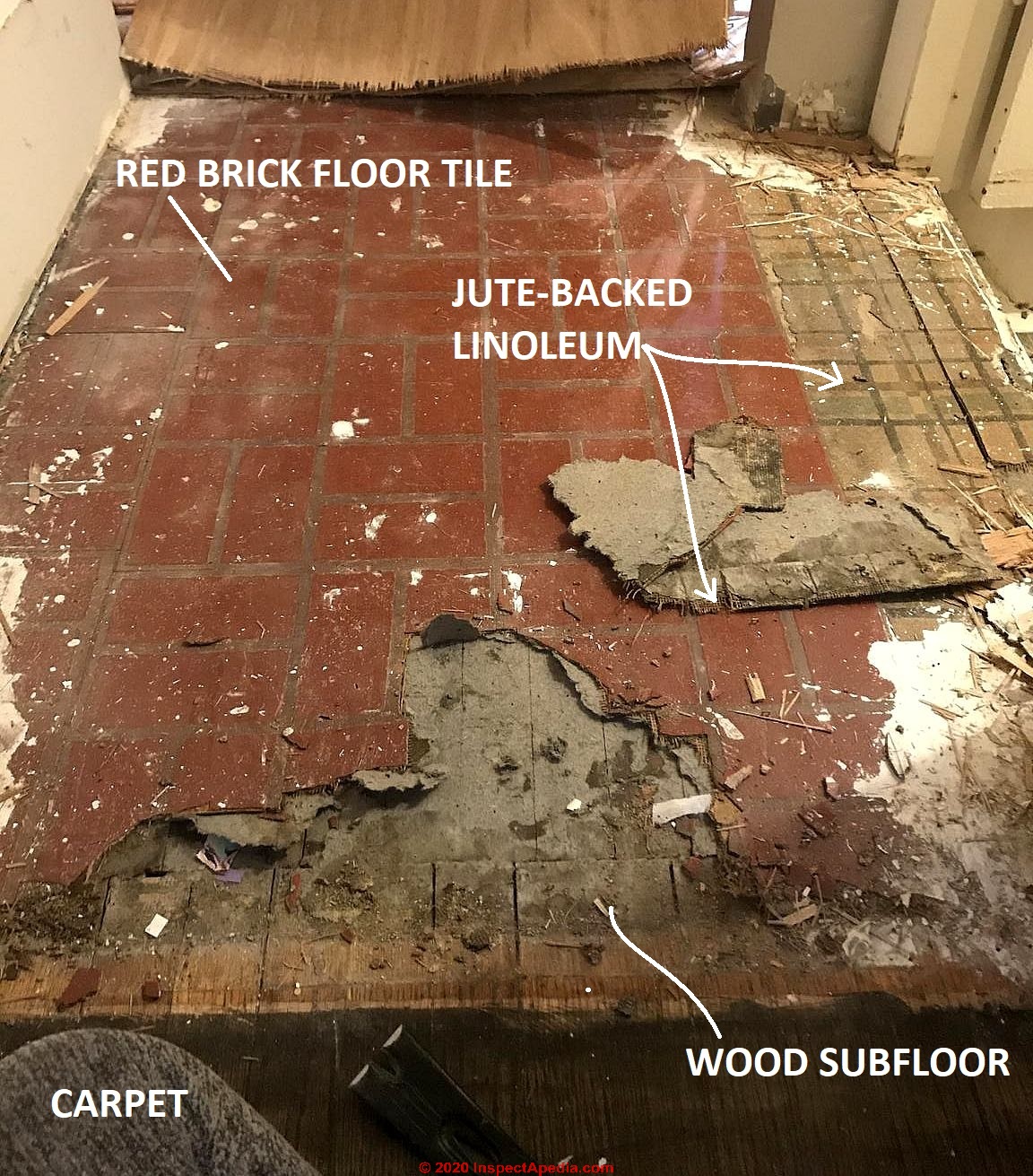 I am attempting to pull up the many layers of flooring in the kitchen of my home (build in 1925)
I am attempting to pull up the many layers of flooring in the kitchen of my home (build in 1925)
I got to the final layer and my brother informed me he believes it looks like old asbestos tile.
Details: coming up in pieces (I unfortunately pulled a few up before knowing) it has a jute backing. It is leaving a gray felt like resident to the hardwood underneath.
Red brick like pattern (pick attached) — I’m concerned, any advice?
This Q&A were posted originally
at RESILIENT SHEET FLOORING ID GUIDE On 2020/04/25 by Courtney G -
Reply by (mod) - jute backed linoleum probably doesn't contain asbestos; red brick pattern vinyl floor tiles may contain asbestos
Courtney you should treat that red brick floor tile (or is it sheet) flooring is presumed to contain asbestos.
You can see more examples of red brick pattern floor tiles on this page.
The jute-backed sheet flooring below is a "linoleum" floor product not normally containing asbestos, though some of that older flooring, when it uses an asphalt-saturated felt ("tar paper") backing, may sport asbestos in the backer.
See details at BURLAP / JUTE - BACKED SHEET FLOORING
See advice at
Humped up sections of particle board - can I cut it out?
 I have two humped up sections where a particle board underlayment swelled 1/4" or more.
I have two humped up sections where a particle board underlayment swelled 1/4" or more.
The underlayment is dry but doesn't feel solid. I think I could get away with replacing less than a 4x8 section, but I would need to slice through the vinyl and whatever it is resting on to get to the particle board.
I was thinking I could slice completely through it with a knife on an oscillating multi tool without creating much dust, then pry apart the particle board underneath so the top materials come off in large pieces with glue still attached.
Nails or screws will pull through, so some debris is unavoidable. Of course using PPE and other precautions.
I don't want to add more subfloor over it because the LVP flooring is already 0.29" thick and will be at least that high above the hardwood outside of the kitchen when installed over this vinyl. On 2019-08-22 by Anonymous
Reply by (mod) -
Ugh.
Unfortunately wet particleboard won't heal itself and you'd not want to floor over it.
Yes cutting with a sharp box cutter can cut most vinyl flooring or sheet flooring with minimal dust.
Use damp wiping and HEPA vacuuming to clean-up in the course of repairs.
Crumbling stuff around Bradford Brick pattern flooring dangerous?
Here is another photo [in addition to the one given above] showing the crumbling material beneath the vinyl, to the right in the photo where the floor HVAC vent is located. The crumbling layer is probably 1/8" thick.
I have a home built in 1960 with a sheet floor in the kitchen that looks like the Bradford Brick pattern shown above with a white backing.
Beneath that, there is a crumbling layer that is thicker and very dark in color that appears to have a paper backing with fibers, and the underlayment beneath that layer is particle board of some sort that has swelled near the sink and dishwasher.
I'm not too worried about the particle board or vinyl sheet, but I am a little concerned about the crumbling stuff in between (see attached photo). Any chance that contains asbestos? I am planning to install floating LVP floor.
If safe to remove, I might rip out all old materials and install new 3/4" underlayment. If not safe, I am inclined to level and seal the old stuff and place the LVP on top. On 2019-08-20 by Anonymous
Reply by (mod) - Bradford Brick pattern flooring: cover-over
I'd leave it alone - as from the age of the home and presumed age of floor it's likely to contain asbestos; you can lay subfloor over it if needed.
Asbestos in 1976 Glenmore brick flooring?
Does Armstrong pattern Glenmore brick installed in a house built in 1976 contain asbestos - On 2019-07-23 by Terry
Reply by (mod) -
Quite possibly. So if you have to make a dusty mess of your floor (better to leave it alone and cover it over) you'll want to test a sample.
If you decide to do so let me know what you find. Any photos can be helpful, especially if you find any packaging for your floor.
We assume flooring is asbestos in a 1963 house: is a layer of underlayment safe enough?
So given the 1963 date on the house, I guess we should assume asbestos to be safe.
I guess the bigger question is, if we put an underlayment between the sheet vinyl (nonfriable) and the new hardwoods, is nailing the T&G hardwood over top considered ok, since we won’t be sanding or grinding the presumed asbestos floor?
My husband is trying to convince me it is, but I find a wide range of opinions on it when I search! Any help would be greatly appreciated! I will add, we have two young kids in the house. Thanks! On 2019-01-13 by Kate
Reply by (mod) -
Kate
That sounds entirely reasonable to me.
How to install hardwood over old asbestos flooring
We’re prepping to install solid hardwoods in our 1963 house in Maryland. We found this brick pattern under the carpet padding in one room. It appears that there are three layers in some rooms (as you can see how the previous owner tiled over all these layers in the photo).
I can’t find it anywhere on your site. It’s definitely a sheet product, and looks to be in good shape, from the small areas we can see, but we haven’t tried messing with it yet.
The other pic is at a floor vent in the next room, with solid hardwood, floated over two layers of newer vinyl over an original layer I think. 3/4” plywood below. Do you know this brick pattern and if it contains asbestos? We’re worried because we already bought nail-down solid hardwoods for this project!
Would it be safe to nail them down with a paper underlayment in between?
IMAGE LOST by older version of Clark Van Oyen’s useful Comments code - now fixed. Please re-post the image if you can. Sorry. Mod.
Sorry, here is the photo at that floor vent. I drew an arrow to the layer that I think might be more brick pattern. Thanks.
IMAGE LOST by older version of Clark Van Oyen’s useful Comments code - now fixed. Please re-post the image if you can. Sorry. Mod. On 2019-01-12 by Kate
Reply by (mod) -
Kate, I can't give an authoritative answer on your brick patter sheet flooring asbestos question from just a photo of the floor edge, but it's easy to use the few question
at DOES THIS FLOOR CONTAIN ASBESTOS?
to get a reasonable guess the asbestos risk. Please take a look at that data and let me know what questions remain - the questions work equally for sheet flooring and for tile flooring
...
Continue reading at ASBESTOS FLOORING HAZARD REDUCTION, or select a topic from the closely-related articles below, or see the complete ARTICLE INDEX.
Or see these
Recommended Articles
- ASBESTOS FLOOR TILE LAB PROCEDURES - gives bit of background on how a lab might test actual flooring samples.
- ASBESTOS FLOORING HAZARD REDUCTION
- ASBESTOS FLOORING IDENTIFICATION
- ASBESTOS FLOORING REMOVAL GUIDE
- ASBESTOS TEST RESULTS for TILE & SHEET FLOORING
- ASBESTOS TESTING LAB LIST if you are faced with a costly, messy demolition of asbestos-suspect sheet or tile flooring
- DOES THIS MATERIAL CONTAIN ASBESTOS? - 5 easy questions to tell if a BUILDING MATERIAL probably contains asbestos -
- DUST / MOLD TEST KIT INSTRUCTIONS gives details on how to collect a dust sample using clear adhesive tape: low cost and easy.
- RESILIENT SHEET FLOORING ID GUIDE
- SHEET & TILE FLOORING ASBESTOS ID-BRICK PATTERN ID
- SHEET & TILE FLOORING ASBESTOS ID-WHITE BRICK
- SHEET FLOORING INSPECT / TEST
- WHITE SHIELD® BACKING ASBESTOS in FLOORING
Suggested citation for this web page
SHEET & TILE FLOORING ASBESTOS ID-BRICK PATTERN ID at InspectApedia.com - online encyclopedia of building & environmental inspection, testing, diagnosis, repair, & problem prevention advice or see this topic index:
INDEX to RELATED ARTICLES: ARTICLE INDEX to ASBESTOS HAZARDS
Or use the SEARCH BOX found below to Ask a Question or Search InspectApedia
Ask a Question or Search InspectApedia
Try the search box just below, or if you prefer, post a question or comment in the Comments box below and we will respond promptly.
Search the InspectApedia website
Note: appearance of your Comment below may be delayed: if your comment contains an image, photograph, web link, or text that looks to the software as if it might be a web link, your posting will appear after it has been approved by a moderator. Apologies for the delay.
Only one image can be added per comment but you can post as many comments, and therefore images, as you like.
You will not receive a notification when a response to your question has been posted.
Please bookmark this page to make it easy for you to check back for our response.
IF above you see "Comment Form is loading comments..." then COMMENT BOX - countable.ca / bawkbox.com IS NOT WORKING.
In any case you are welcome to send an email directly to us at InspectApedia.com at editor@inspectApedia.com
We'll reply to you directly. Please help us help you by noting, in your email, the URL of the InspectApedia page where you wanted to comment.
Citations & References
In addition to any citations in the article above, a full list is available on request.
- Kueber, Pam, The history of Armstrong Flooring's Pattern #5352 — the best-selling resilient flooring pattern of the 20th Century (2021) - article hosted at Retro-Renovation https://retrorenovation.com/2020/03/31/history-armstrong-flooring-pattern-5352-best-selling-20th-century/ retrieved 2024/10/22
- Richa Wilson, Kathleen Snodgrass, EARLY 20TH-CENTURY BUILDING MATERIALS: RESILIENT FLOORING [Very large PDF], Richa Wilson, Intermountain Regional Architectural Historian Kathleen Snodgrass, Project Leader, United States Department of Agriculture Forest Service, Technology & Development Program, August 2007, 7300-0773-2322-MTDC. Contact Kathie Snodgrass at MTDC: Tel: 406–329–3922, Email: ksnodgrass@fs.fed.us or Richa Wilson, author; USDA Forest Service, Intermountain Region, 324 25th Street, Ogden, UT 84401. Phone: 801–625–5704; fax: 801–625–5229: e-mail: rwilson@fs.fed.us
- Resilient Floor Covering Institute, 401 East Jefferson Street, Suite 102, Rockville, MD 20850, Tel: 301–340–8580, Website: http://www.rfci.com
- In addition to citations & references found in this article, see the research citations given at the end of the related articles found at our suggested
CONTINUE READING or RECOMMENDED ARTICLES.
- Carson, Dunlop & Associates Ltd., 120 Carlton Street Suite 407, Toronto ON M5A 4K2. Tel: (416) 964-9415 1-800-268-7070 Email: info@carsondunlop.com. Alan Carson is a past president of ASHI, the American Society of Home Inspectors.
Thanks to Alan Carson and Bob Dunlop, for permission for InspectAPedia to use text excerpts from The HOME REFERENCE BOOK - the Encyclopedia of Homes and to use illustrations from The ILLUSTRATED HOME .
Carson Dunlop Associates provides extensive home inspection education and report writing material. In gratitude we provide links to tsome Carson Dunlop Associates products and services.



